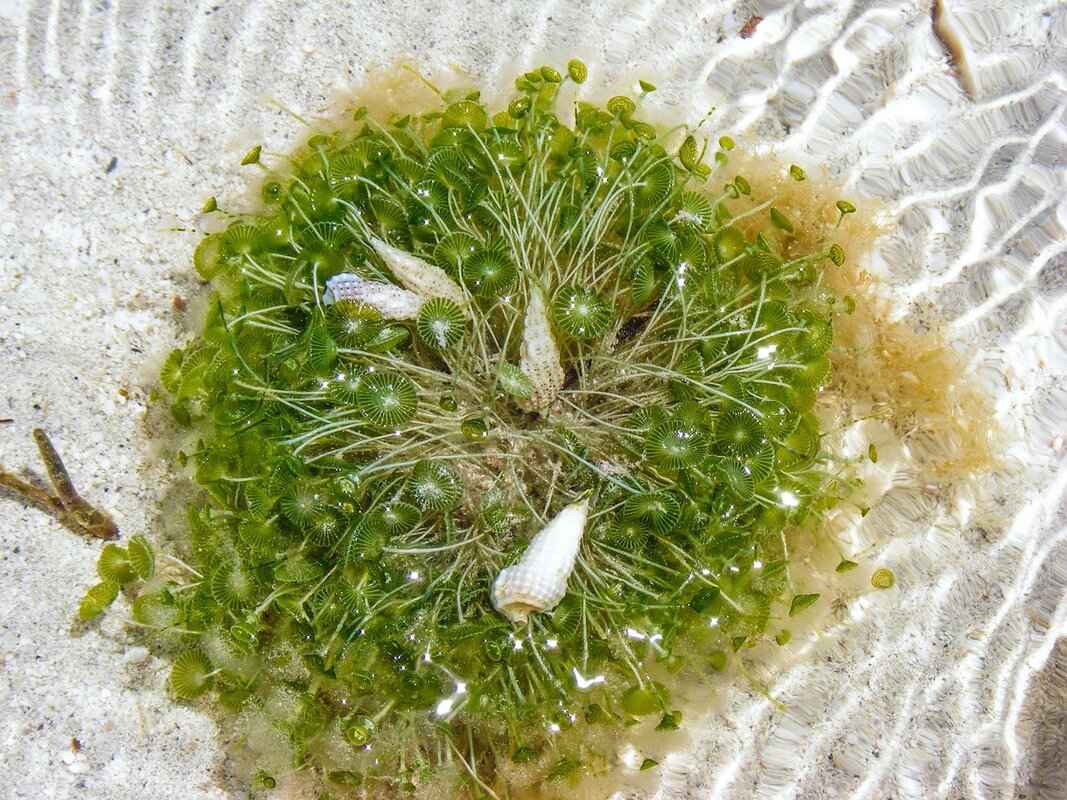This article explores the remarkable anti-aging properties of seaweed, a staple in Japanese and Korean diets, and its impact on skin health, nutrient richness, and overall wellness. Seaweed is not only a culinary delight but also a powerhouse of nutrients that can significantly enhance our skin’s vitality and overall health.
Seaweed is packed with essential vitamins and minerals that contribute to its anti-aging properties. Some of the key nutrients include:
- Vitamins A, C, and E: These vitamins are known for their antioxidant properties, which help in reducing the appearance of fine lines and wrinkles.
- Minerals: Rich in minerals like calcium, magnesium, and iron, seaweed supports skin health and overall bodily functions.
- Omega-3 Fatty Acids: Essential for maintaining skin hydration and elasticity.
The unique compounds found in seaweed, such as antioxidants and omega-3 fatty acids, play a significant role in promoting skin elasticity and hydration. Antioxidants help combat oxidative stress, a major contributor to skin aging, while omega-3 fatty acids support the skin’s natural barrier.
Antioxidants in seaweed combat oxidative stress, which is a major contributor to skin aging. Some specific antioxidants found in various types of seaweed include:
- Fucoxanthin: A carotenoid that helps reduce inflammation and improve skin tone.
- Vitamin C: Promotes collagen production, essential for maintaining skin firmness.
Different varieties of seaweed offer unique antioxidant profiles. For instance:
- Nori: Commonly used in sushi, it is rich in vitamins and minerals.
- Kombu: Known for its umami flavor, it is also packed with iodine and antioxidants.
- Wakame: Often used in soups and salads, it has high levels of omega-3 fatty acids.
Omega-3 fatty acids are crucial for maintaining skin barrier function. They help in:
- Reducing Inflammation: This can lead to a clearer complexion and fewer breakouts.
- Enhancing Hydration: Keeping skin moisturized and plump.
Incorporating seaweed into meals can be both delicious and beneficial. Here are some culinary applications:
- Soups: Seaweed can be added to miso soup or broth for added flavor and nutrition.
- Salads: Seaweed salads are a popular dish in Japanese cuisine, often dressed with sesame oil and vinegar.
- Snacks: Roasted seaweed snacks are a tasty, low-calorie option.
While seaweed is highly nutritious, there are potential risks to consider. It is essential to consume it in moderation due to its high iodine content.
Seaweed is rich in iodine, which can be beneficial but also harmful in excess. Monitoring iodine intake is crucial, especially for individuals with thyroid issues.
Not all seaweed products are created equal. Here are tips on selecting high-quality seaweed:
- Source: Look for sustainably harvested seaweed.
- Organic Certification: Choose organic products to avoid contaminants.

What Are the Key Nutrients in Seaweed?
Seaweed, a cornerstone of Japanese and Korean cuisine, is not only a flavorful addition to meals but also a nutrient-dense superfood that boasts impressive anti-aging properties. Understanding the key nutrients found in seaweed can significantly enhance our appreciation of its role in promoting skin health and overall vitality.
Seaweed is rich in a variety of essential vitamins and minerals that contribute to its anti-aging benefits. These nutrients include:
- Vitamins: Seaweed is an excellent source of vitamins A, C, E, and K, which are crucial for skin health. Vitamin A promotes skin cell regeneration, while Vitamin C aids in collagen production, enhancing skin elasticity.
- Minerals: It is packed with essential minerals like calcium, magnesium, and iron. Calcium helps maintain skin structure, while magnesium supports skin hydration and repair.
- Antioxidants: Seaweed contains a variety of antioxidants, including flavonoids and carotenoids, which help combat oxidative stress, a major factor in skin aging.
- Omega-3 Fatty Acids: These essential fatty acids are vital for maintaining skin barrier function and hydration, contributing to a youthful appearance.
Understanding these nutrients helps us appreciate how they work synergistically to enhance skin health. For instance, the combination of vitamins and antioxidants can protect against UV damage, reducing the appearance of fine lines and wrinkles.
The unique compounds found in seaweed, such as antioxidants and omega-3 fatty acids, play a significant role in promoting skin elasticity and hydration. Let’s delve into these benefits further.
Antioxidants in seaweed combat oxidative stress, which is a major contributor to skin aging. By neutralizing free radicals, these antioxidants help to protect the skin from damage caused by environmental factors such as pollution and UV radiation. Various types of seaweed, including nori, kombu, and wakame, are known for their high antioxidant content, each providing unique benefits for skin health.
Omega-3 fatty acids are crucial for maintaining skin barrier function. They help to lock in moisture, keeping the skin hydrated and plump. Additionally, omega-3s have anti-inflammatory properties that can soothe irritated skin and reduce redness, making them particularly beneficial for those with sensitive skin.
Incorporating seaweed into meals can be both delicious and beneficial. Seaweed can be used in a variety of dishes, from soups and salads to sushi and snacks. Its versatility makes it easy to add to your diet.
There are numerous ways to incorporate seaweed into your meals:
- Add dried seaweed flakes to salads for an umami flavor.
- Use nori sheets to wrap sushi or as a low-calorie snack.
- Include kelp in soups for added nutrients and flavor.
Traditional Japanese and Korean dishes often highlight seaweed. Popular recipes include miso soup with wakame, seaweed salad, and kimchi that incorporates various seaweed types. These dishes not only showcase the culinary versatility of seaweed but also its health benefits.
While seaweed is highly nutritious, there are potential risks to consider. It is important to consume it in moderation and ensure that you are sourcing quality seaweed to avoid excessive iodine intake.
Seaweed is rich in iodine, which can be beneficial for thyroid health but may lead to negative effects if consumed in excess. Monitoring your iodine intake from seaweed is crucial to avoid potential health issues.
Not all seaweed products are created equal. Look for organic options and check for certifications to ensure you are getting high-quality seaweed that maximizes health benefits.

How Does Seaweed Promote Skin Health?
Seaweed has long been celebrated in Japanese and Korean cuisine, not only for its unique flavors but also for its remarkable health benefits. Among these benefits, the promotion of skin health stands out, making seaweed a valuable ally in the quest for youthful, radiant skin. This section will explore how seaweed contributes to skin health through its rich composition of antioxidants and omega-3 fatty acids.
The unique compounds found in seaweed, such as antioxidants and omega-3 fatty acids, play a significant role in promoting skin elasticity and hydration. Let’s delve into these benefits further.
Seaweed is abundant in various antioxidants, including vitamin C, vitamin E, and phycocyanin. These powerful compounds help combat oxidative stress, a leading factor in skin aging. By neutralizing free radicals, antioxidants protect skin cells from damage, thereby reducing the appearance of fine lines and wrinkles.
Omega-3 fatty acids, particularly EPA and DHA, are integral to maintaining skin barrier function. These fatty acids help to retain moisture, keeping the skin hydrated and plump. Additionally, they possess anti-inflammatory properties that can soothe irritated skin, making seaweed an excellent choice for those with sensitive skin conditions.
The combination of antioxidants and omega-3 fatty acids in seaweed not only hydrates the skin but also enhances its elasticity. This is crucial as skin elasticity diminishes with age. Regular consumption of seaweed can help maintain the skin’s firmness, giving it a more youthful appearance.
- Nori: Commonly used in sushi, nori is rich in antioxidants and vitamins that promote skin health.
- Kombu: This type of seaweed is packed with minerals and is known for its hydrating properties.
- Wakame: Often found in miso soup, wakame is celebrated for its ability to improve skin elasticity and moisture levels.
Incorporating seaweed into your daily meals is easier than you might think. Here are some practical tips:
- Add dried seaweed to soups and stews for an umami boost.
- Use seaweed flakes as a seasoning for salads and vegetables.
- Blend seaweed into smoothies for an extra nutrient kick.
By integrating these types of seaweed into your diet, you can reap the numerous skin benefits they offer while enjoying delicious meals.
In summary, the unique compounds found in seaweed, including antioxidants and omega-3 fatty acids, work synergistically to enhance skin health. From promoting hydration to improving elasticity, seaweed is a powerhouse of nutrients that can significantly contribute to a youthful complexion. Whether enjoyed in traditional dishes or as a supplement, the benefits of seaweed for skin health are clear and compelling.
What Role Do Antioxidants Play?
Antioxidants are vital compounds that play a crucial role in combating oxidative stress, a significant factor in skin aging. In the context of seaweed, these natural substances help protect skin cells from damage caused by free radicals, which are unstable molecules that can lead to premature aging and various skin conditions. This section will delve deeper into the specific antioxidants found in different types of seaweed and their benefits for skin health.
Oxidative stress occurs when there is an imbalance between free radicals and antioxidants in the body. This imbalance can result from various factors, including environmental pollutants, UV radiation, and poor diet. Over time, oxidative stress can lead to skin issues such as fine lines, wrinkles, and loss of elasticity.
Seaweed is rich in several types of antioxidants, each contributing uniquely to skin health:
- Vitamin C: This powerful antioxidant helps in collagen synthesis, promoting skin firmness and reducing the appearance of wrinkles.
- Vitamin E: Known for its moisturizing properties, Vitamin E protects skin cells from oxidative damage and enhances overall skin texture.
- Flavonoids: These plant compounds have anti-inflammatory properties and can help soothe irritated skin while providing a protective barrier against environmental stressors.
- Carotenoids: Found in various seaweed types, carotenoids help in skin repair and protection against UV damage.
At a cellular level, antioxidants neutralize free radicals by donating electrons, which stabilizes these harmful molecules and prevents them from causing cellular damage. This process is essential for maintaining skin health and preventing signs of aging. Additionally, antioxidants can enhance the skin’s natural defense mechanisms, promoting a radiant and youthful appearance.
Different types of seaweed offer distinct profiles of antioxidants:
| Type of Seaweed | Key Antioxidants | Skin Benefits |
|---|---|---|
| Nori | Vitamin C, Carotenoids | Promotes collagen production, enhances skin elasticity |
| Kombu | Vitamin E, Flavonoids | Moisturizes skin, reduces inflammation |
| Wakame | Fucoxanthin, Vitamin C | Helps in skin repair, protects against UV damage |
To harness the antioxidant benefits of seaweed, consider incorporating it into your skincare routine. Look for products that contain seaweed extracts or even explore DIY options by adding powdered seaweed to your homemade masks and scrubs. Regular use can enhance your skin’s resilience and overall appearance.
In conclusion, the antioxidants found in seaweed are powerful allies in the fight against oxidative stress and skin aging. By understanding their roles and incorporating seaweed into both your diet and skincare regimen, you can promote healthier, more youthful skin.
Which Types of Seaweed Are Most Beneficial?
Seaweed has gained significant attention in recent years for its impressive health benefits, particularly in the realm of skin health. Among the diverse varieties of seaweed, three types stand out for their unique antioxidant profiles: nori, kombu, and wakame. Each of these seaweeds offers distinct properties that can contribute to healthier, more youthful skin.
- Nori: Commonly used in sushi, nori is not just a culinary favorite but also a powerhouse of nutrients. Rich in vitamins A, C, and E, it provides essential antioxidants that help combat free radicals, which are known to accelerate skin aging. Additionally, nori contains omega-3 fatty acids that promote skin hydration and elasticity.
- Kombu: This thick, kelp-like seaweed is often used in broths and soups. Kombu is particularly high in fucoidan, a type of polysaccharide that has been shown to have anti-inflammatory and antioxidant properties. These qualities make kombu an excellent choice for maintaining skin health, as it helps reduce redness and irritation, promoting a more even skin tone.
- Wakame: Often found in miso soup and salads, wakame is another nutrient-rich seaweed. It contains a potent antioxidant called carotenoids, which help protect the skin from UV damage. Furthermore, wakame is known for its ability to enhance skin hydration, making it an ideal ingredient for those looking to maintain a youthful glow.
The unique compositions of these seaweeds not only provide essential nutrients but also work synergistically to enhance skin health. Antioxidants found in seaweed play a critical role in protecting skin cells from oxidative stress, which is a leading cause of premature aging. By incorporating these varieties into your diet, you can harness their benefits for your skin.
In addition to their antioxidant properties, each type of seaweed also offers a variety of vitamins and minerals that are crucial for overall skin health. For example, the high iodine content in kombu supports thyroid function, which can influence skin vitality. Meanwhile, the vitamins in nori contribute to collagen production, essential for maintaining skin firmness.
When considering the best seaweed for your skin, it’s important to note that variety is key. Incorporating a mix of nori, kombu, and wakame into your meals can provide a comprehensive array of nutrients that work together to enhance skin health. Whether you enjoy them in soups, salads, or as snacks, these seaweeds can easily be integrated into your daily diet.
To maximize the benefits, look for high-quality, sustainably sourced seaweed products. This ensures that you are getting the most potent nutrients without harmful additives or contaminants. With the right choices, you can enjoy the numerous health benefits that these seaweeds offer.
By understanding the unique properties of nori, kombu, and wakame, you can make informed dietary choices that not only satisfy your taste buds but also support your skin health. Embracing these nutrient-dense seaweeds can be a delicious step toward achieving a more youthful and vibrant complexion.
How Do Antioxidants Work on a Cellular Level?
Antioxidants are vital compounds that help protect our cells from damage caused by free radicals, which are unstable molecules that can lead to oxidative stress. This process is a significant contributor to skin aging and various skin conditions. Understanding how antioxidants work on a cellular level can illuminate their protective mechanisms, particularly in relation to skin health.
Free radicals are generated through various sources, including environmental pollution, UV radiation, and even metabolic processes within our bodies. When the balance between free radicals and antioxidants is disrupted, oxidative stress occurs, leading to cellular damage. This damage can manifest as wrinkles, fine lines, and loss of skin elasticity.
Antioxidants neutralize free radicals by donating an electron, thus stabilizing these unstable molecules. This action prevents further cellular damage and helps maintain the integrity of skin cells. Key antioxidants found in seaweed, such as vitamin C, vitamin E, and beta-carotene, play crucial roles in this protective process.
At the cellular level, antioxidants interact with various cellular components, including membranes, proteins, and DNA. They help to:
- Protect Cell Membranes: Antioxidants stabilize cell membranes by preventing lipid peroxidation, which can lead to cell death.
- Support DNA Repair: By mitigating oxidative damage to DNA, antioxidants promote cellular repair mechanisms, reducing the risk of mutations that can lead to skin cancer.
- Enhance Collagen Production: Certain antioxidants stimulate fibroblast activity, which is essential for collagen synthesis, thereby maintaining skin firmness and elasticity.
Different antioxidants offer unique benefits for skin health:
- Vitamin C: Known for its brightening effects, vitamin C also aids in collagen production and protects against UV damage.
- Vitamin E: This fat-soluble antioxidant helps protect skin from oxidative stress and supports skin hydration.
- Polyphenols: Found in various seaweeds, polyphenols have anti-inflammatory properties that can soothe irritated skin.
Chronic inflammation is a key factor in skin aging. Antioxidants help reduce inflammation by neutralizing free radicals and modulating inflammatory pathways. By doing so, they can slow down the aging process and improve overall skin texture and tone.
Topical application of antioxidant-rich products can enhance skin defense mechanisms. Ingredients derived from seaweed, such as fucoidan and laminarin, have shown promising results in skin absorption, providing localized protection against oxidative stress.
To maximize the benefits of antioxidants, consider incorporating products that contain seaweed extracts or other antioxidant-rich ingredients. Look for serums, moisturizers, and masks that highlight these components. Additionally, consuming foods high in antioxidants, such as seaweed, can support skin health from the inside out.
In conclusion, understanding the cellular mechanisms of antioxidants reveals their critical role in protecting skin from aging. By neutralizing free radicals, supporting cellular repair, and reducing inflammation, antioxidants are essential for maintaining youthful, healthy skin.
How Do Omega-3 Fatty Acids Benefit the Skin?
Omega-3 fatty acids are essential for maintaining optimal skin health, playing a pivotal role in enhancing skin barrier function and overall hydration. These fatty acids, primarily derived from sources like fish and seaweed, are renowned for their anti-inflammatory properties, which can significantly benefit skin conditions and promote a youthful appearance.
Omega-3 fatty acids are a type of polyunsaturated fat that the body cannot produce on its own, making it crucial to obtain them through diet. They are primarily found in fatty fish, flaxseeds, and seaweed. In particular, seaweed is a sustainable source of omega-3s, making it an excellent option for vegetarians and vegans.
One of the main benefits of omega-3 fatty acids in skincare is their ability to strengthen the skin barrier. A robust skin barrier is essential for retaining moisture and protecting against environmental aggressors. Here’s how omega-3s contribute:
- Enhancing Hydration: Omega-3 fatty acids help to lock in moisture, preventing dryness and flakiness. This is particularly beneficial for individuals with dry or sensitive skin.
- Reducing Inflammation: These fatty acids possess anti-inflammatory properties that can alleviate conditions like eczema and psoriasis. By reducing inflammation, omega-3s help to soothe irritated skin.
- Promoting Elasticity: Omega-3s support collagen production, which is vital for maintaining skin elasticity. This can lead to a more youthful appearance and reduced signs of aging.
On a cellular level, omega-3 fatty acids influence skin health by modulating cell membrane fluidity. This allows for better nutrient absorption and waste elimination. Additionally, they play a role in the production of lipid mediators, which are compounds that help regulate inflammation and skin cell turnover.
Several types of seaweed are particularly high in omega-3 fatty acids. For instance:
- Kombu: Known for its rich nutrient profile, kombu contains a significant amount of omega-3s, making it a great addition to soups and broths.
- Wakame: Often used in salads and miso soup, wakame is not only delicious but also a fantastic source of omega-3s.
- Nori: Commonly used in sushi, nori is another excellent source of omega-3 fatty acids, providing both flavor and health benefits.
Incorporating omega-3-rich seaweed into your meals is simple and versatile. Here are some practical tips:
- Add dried nori sheets to salads or use them as a wrap for sushi.
- Include kombu in soups or stews to enhance flavor and nutrition.
- Mix wakame into your salads or serve it as a side dish.
In conclusion, omega-3 fatty acids derived from seaweed are vital for maintaining skin health. Their ability to enhance hydration, reduce inflammation, and promote elasticity makes them an essential component of a healthy diet. By incorporating various types of seaweed into your meals, you can easily reap the numerous skin benefits they offer.

What Are the Culinary Uses of Seaweed?
Seaweed is not just a health food; it is a culinary treasure that has been embraced in Japanese and Korean cuisines for centuries. Its unique flavors and textures add depth to various dishes, making it a versatile ingredient that can be enjoyed in numerous ways. This section delves into the diverse culinary applications of seaweed, showcasing how it can enhance both meals and health.
In Japanese cuisine, seaweed is a fundamental component, often used to elevate the taste and nutritional value of dishes. One of the most popular forms is nori, which is commonly used to wrap sushi. This edible seaweed not only adds a savory flavor but also provides essential nutrients, including vitamins A, C, and E.
- Miso Soup: Kombu, a type of kelp, is often used as a base for miso soup. It imparts a rich umami flavor and is packed with minerals.
- Salads: Wakame, another variety of seaweed, is frequently included in salads, offering a refreshing taste and a boost of antioxidants.
- Rice Dishes: Seaweed can be sprinkled over rice or mixed into rice dishes, adding both flavor and texture.
Similarly, in Korean cuisine, seaweed plays a crucial role. One of the most beloved dishes is miyeok-guk, a seaweed soup traditionally consumed for birthdays and postpartum recovery. This dish showcases the health benefits of seaweed, particularly its rich iodine content.
- Seaweed Salad: Korean seaweed salads often feature gim, toasted seaweed that is seasoned with sesame oil and salt, providing a crunchy and flavorful side dish.
- Rice Rolls: Just like in Japan, seaweed is used in Korean rice rolls, where it wraps rice and various fillings, making for a nutritious snack.
- Pancakes: Seaweed can also be incorporated into savory pancakes, adding a unique taste and texture to this popular dish.
In addition to its culinary versatility, seaweed is renowned for its health benefits. Rich in minerals and vitamins, it supports overall health and wellness. The antioxidants found in seaweed help combat oxidative stress, while its high fiber content aids digestion.
Moreover, seaweed is low in calories yet high in essential nutrients, making it an excellent addition to any meal. By incorporating seaweed into your diet, you not only enhance the flavor of your dishes but also provide your body with a wealth of health benefits.
Integrating seaweed into your meals is simpler than you might think. Here are some practical tips:
- Start with snacks: Try roasted seaweed snacks as a healthy alternative to chips.
- Add to smoothies: Blend seaweed powder into your smoothies for an extra nutrient boost.
- Experiment with recipes: Look for recipes that incorporate seaweed, such as soups, salads, and stir-fries.
By exploring the culinary uses of seaweed in both Japanese and Korean cuisines, you can enjoy its delicious flavors while reaping its numerous health benefits. Whether you are a seasoned chef or a culinary novice, seaweed offers endless possibilities to enhance your meals.
How Can You Add Seaweed to Your Diet?
Incorporating seaweed into your daily meals is not only a way to enhance flavor but also a means to boost your health. This versatile ingredient is rich in nutrients and can be easily added to various dishes. Here are some practical tips on how to seamlessly include seaweed in your diet.
- Add to Soups: Seaweed can be a fantastic addition to soups, especially in traditional dishes like miso soup or seaweed soup. Simply add dried seaweed, such as wakame, to your broth for added depth and nutrition.
- Enhance Salads: Incorporate seaweed into salads for a unique twist. You can use nori flakes or strips as a topping or mix in seaweed salad as a base for your greens. This not only adds flavor but also a crunchy texture.
- Use in Sushi: One of the most popular uses of seaweed is in sushi. Nori sheets are essential for wrapping sushi rolls. You can also create sushi bowls with rice, vegetables, and seaweed for a quick meal.
- Blend into Smoothies: For the adventurous eater, adding a small amount of powdered seaweed, like spirulina, to smoothies can enhance the nutrient profile without overpowering the flavor.
- Make Seaweed Snacks: Seaweed snacks are a trendy and healthy alternative to traditional chips. You can find pre-packaged options or make your own by roasting sheets of nori with a sprinkle of salt.
Preparing seaweed at home can be simple and rewarding. Here are a few methods:
- Rehydration: Dried seaweed often needs to be rehydrated before use. Soak it in warm water for a few minutes until it expands and becomes tender.
- Cooking: Depending on the type of seaweed, you can boil or steam it. Kombu, for instance, is often simmered in water to make a flavorful broth.
- Seasoning: Experiment with different seasonings. A splash of soy sauce, sesame oil, or rice vinegar can elevate the flavor of your seaweed dishes.
Here are a few creative recipes to inspire you:
- Seaweed and Tofu Stir-Fry: Combine sautéed tofu with your choice of vegetables and add rehydrated seaweed for a nutritious stir-fry.
- Seaweed Pesto: Blend seaweed with nuts, garlic, olive oil, and parmesan for a unique twist on traditional pesto.
- Seaweed Rice Balls: Mix cooked rice with chopped seaweed and shape them into balls for a healthy snack.
By integrating seaweed into your meals, you can enjoy its numerous health benefits while also diversifying your diet. Whether you prefer it in a soup, salad, or snack, seaweed is a versatile ingredient that can enhance both flavor and nutrition.
What Are Some Traditional Dishes Featuring Seaweed?
Seaweed is a remarkable ingredient that plays a significant role in both Japanese and Korean cuisines. Often celebrated for its nutritional benefits, seaweed is not just a garnish but a key component in many traditional dishes. This section explores some of the most popular dishes featuring seaweed, showcasing its versatility and health benefits.
- Miso Soup – A staple in Japanese households, miso soup often includes wakame, a type of seaweed that adds a unique flavor and a wealth of nutrients. This dish is not only comforting but also rich in antioxidants, making it a perfect start to any meal.
- Seaweed Salad – Commonly found in both Japanese and Korean cuisine, seaweed salad typically features nori or kombu. Dressed with sesame oil and vinegar, this salad is both refreshing and packed with vitamins A, C, and E, contributing to skin health.
- Gimbap – A popular Korean dish, gimbap consists of rice and various fillings wrapped in nori. This dish is not only visually appealing but also provides a balanced meal, combining the health benefits of seaweed with proteins and vegetables.
- Onigiri – Japanese rice balls that are often wrapped in nori, onigiri can be filled with a variety of ingredients, from pickled plums to grilled salmon. The seaweed adds a delightful crunch and enhances the flavor profile.
- Chawanmushi – This savory egg custard dish often incorporates wakame for added depth and nutrition. The delicate texture combined with the umami flavor of seaweed makes it a comforting choice.
The incorporation of seaweed in these traditional dishes not only enhances flavor but also provides a multitude of health benefits. Seaweed is rich in iodine, essential for thyroid function, and it contains omega-3 fatty acids, which are vital for maintaining healthy skin. Furthermore, the antioxidants found in seaweed help combat oxidative stress, contributing to overall wellness and longevity.
Seaweed is often referred to as a superfood due to its impressive nutrient profile. It is low in calories yet high in fiber, making it an excellent addition to any diet. Additionally, the vitamins and minerals found in seaweed, such as calcium, magnesium, and iron, support various bodily functions and promote a healthy lifestyle.
Incorporating seaweed into your diet can be both easy and delicious. Here are a few practical tips:
- Add nori to your sandwiches or wraps for an extra crunch.
- Use kombu to make flavorful broths for soups and stews.
- Sprinkle dried seaweed flakes on salads or rice dishes for added flavor and nutrients.
- Experiment with seaweed snacks, which are a healthy alternative to traditional chips.
By exploring these traditional dishes and incorporating seaweed into your meals, you can enjoy not only the delightful flavors but also the numerous health benefits that this incredible superfood has to offer.

Are There Any Risks Associated with Seaweed Consumption?
Seaweed has garnered attention for its numerous health benefits, particularly in Japanese and Korean cuisines. However, it is essential to recognize that while seaweed is highly nutritious, there are potential risks associated with its consumption. This section outlines the importance of moderation and sourcing quality seaweed to maximize its benefits while minimizing potential health concerns.
Seaweed is a powerhouse of nutrients, including vitamins, minerals, and antioxidants. It is especially rich in iodine, which is vital for thyroid function. However, excessive iodine intake can lead to thyroid dysfunction, making it crucial to consume seaweed in moderation.
Moderation is essential when incorporating seaweed into your diet. The recommended daily intake of iodine for adults is 150 micrograms, but various seaweed types can contain significantly higher levels. For instance, certain varieties of kombu can contain up to 2,500 micrograms of iodine per serving. Consuming seaweed excessively can lead to conditions such as hyperthyroidism or hypothyroidism.
Another concern with seaweed consumption is the potential for heavy metal accumulation. Seaweed can absorb heavy metals from the ocean, including lead, cadmium, and arsenic. Regular consumption of contaminated seaweed may pose health risks over time. Therefore, sourcing quality seaweed from reputable suppliers is crucial.
- Look for Certifications: Choose seaweed products that are certified organic or have undergone testing for heavy metals.
- Check Sourcing Information: Opt for seaweed sourced from clean waters, away from industrial pollution.
- Read Labels Carefully: Look for brands that provide information on iodine content and quality assurance.
Some individuals may experience allergic reactions to seaweed. Symptoms can include skin irritation, gastrointestinal discomfort, or respiratory issues. If you have a history of food allergies, it is advisable to consult a healthcare professional before adding seaweed to your diet.
Certain medications, particularly those affecting thyroid function or blood coagulation, may interact negatively with high iodine levels from seaweed. If you are on medication, it’s essential to consult your doctor to ensure safe consumption.
Be aware of the signs of overconsumption of seaweed, which may include:
- Thyroid dysfunction: Symptoms may include weight changes, fatigue, and mood swings.
- Gastrointestinal issues: Excessive fiber intake from seaweed can lead to bloating or digestive discomfort.
In conclusion, while seaweed offers numerous health benefits, it is important to approach its consumption with caution. By understanding the risks associated with iodine levels, heavy metal accumulation, and potential allergies, you can enjoy the nutritional advantages of seaweed while minimizing health concerns. Always prioritize quality and moderation in your dietary choices to reap the full benefits of this remarkable superfood.
What Should You Know About Iodine Levels?
Seaweed is a remarkable food source, celebrated not only for its culinary uses but also for its impressive nutritional profile. Among its many benefits, seaweed is particularly known for its high iodine content, which is essential for maintaining healthy thyroid function. However, understanding the balance of iodine intake is crucial, as both deficiency and excess can lead to health issues.
Iodine is a vital trace element that plays a key role in the production of thyroid hormones. These hormones are critical for regulating metabolism, growth, and development. A proper level of iodine is essential for ensuring that the thyroid gland functions optimally, contributing to overall health and wellness.
The iodine content in seaweed can vary significantly depending on the type and where it is harvested. For instance, varieties such as kombu can contain up to 2,000 micrograms of iodine per gram, while others like nori have lower levels, around 16 micrograms per gram. This wide range emphasizes the importance of being aware of the specific type of seaweed being consumed.
While iodine is essential, excessive intake can lead to health complications, including hyperthyroidism or thyroiditis. Symptoms may include rapid heartbeat, weight loss, and anxiety. It is crucial to monitor iodine levels, especially for individuals who consume seaweed regularly or those who have pre-existing thyroid conditions.
- Keep track of the types and amounts of seaweed consumed.
- Consult with a healthcare professional, especially if you have thyroid issues.
- Consider iodine levels in other dietary sources, such as iodized salt and dairy products.
Individuals with thyroid disorders, pregnant women, and those on certain medications should exercise caution with their iodine intake. It’s advisable to consult a healthcare provider to determine appropriate dietary choices and to ensure that iodine levels remain within a healthy range.
To enjoy the benefits of seaweed without the risks associated with excessive iodine, consider the following recommendations:
- Limit consumption to small amounts a few times a week.
- Choose seaweed varieties with lower iodine content, such as nori.
- Incorporate a variety of foods in your diet to balance nutrient intake.
In conclusion, while seaweed is a nutrient-dense food with many health benefits, it is essential to be mindful of iodine levels. By understanding the iodine content in different types of seaweed and monitoring overall intake, you can enjoy this superfood while maintaining optimal health.
How to Choose Quality Seaweed Products?
When it comes to incorporating seaweed into your diet, quality matters. Not all seaweed products are created equal, and selecting the right type can significantly affect the health benefits you receive. Here are some essential tips to help you choose high-quality seaweed products.
Choosing organic seaweed is crucial as it ensures that the product is free from harmful pesticides and chemicals. Organic certification also indicates that the seaweed has been harvested sustainably, which is important for both your health and the environment.
Freshness is another key factor in selecting seaweed. Look for products that have a vibrant color and a pleasant, ocean-like aroma. Avoid any seaweed that appears dull or has an off-putting smell, as these can be signs of spoilage.
Quality seaweed should be packaged in a way that protects it from light and moisture. Opaque packaging is preferable, as it helps maintain the seaweed’s integrity. Check for any signs of damage or tampering, as this can compromise the quality of the product.
Understanding where your seaweed comes from is essential. Seaweed harvested from clean, unpolluted waters is more likely to be of high quality. Look for brands that provide information about their sourcing practices and the specific regions they harvest from.
When selecting processed seaweed products, such as snacks or supplements, always read the ingredients list. Avoid products with unnecessary additives, preservatives, or artificial flavors. Ideally, the ingredients should be simple and natural.
Different types of seaweed offer varying health benefits. For example, nori is rich in protein and vitamins, while kombu is known for its high iodine content. Understanding the specific benefits of each type can help you choose the best option for your dietary needs.
Reputable brands often undergo third-party testing to ensure their products meet safety and quality standards. Look for certifications or seals from independent organizations that verify the purity and potency of the seaweed.
Don’t hesitate to seek advice from health food stores or nutritionists who are familiar with seaweed products. They can provide valuable insights and recommend trusted brands that prioritize quality.
Lastly, consider the environmental impact of the seaweed you choose. Sustainable harvesting practices not only protect marine ecosystems but also ensure the long-term availability of high-quality seaweed. Look for brands that emphasize sustainability in their sourcing practices.
By following these tips, you can confidently select high-quality seaweed products that maximize the health benefits associated with this nutrient-rich superfood. Whether you’re adding it to your meals or using it in skincare, quality seaweed can play a significant role in enhancing your overall wellness.
Frequently Asked Questions
- What are the main health benefits of seaweed?
Seaweed is a powerhouse of nutrients! It’s packed with vitamins, minerals, and antioxidants that help promote skin health, boost hydration, and combat signs of aging. Think of it as nature’s little secret for youthful skin!
- Can I eat seaweed every day?
While seaweed is incredibly nutritious, moderation is key. Consuming it daily is fine for most people, but be mindful of iodine levels. Too much iodine can lead to health issues, so it’s best to mix it up with other foods!
- How can I incorporate seaweed into my meals?
There are so many delicious ways to enjoy seaweed! You can add it to soups, salads, or even smoothies. Try making a tasty seaweed salad or using nori sheets in sushi. It’s a fun way to boost your meals!
- What types of seaweed are best for skin health?
Nori, kombu, and wakame are among the best! Each variety has unique properties that can enhance skin elasticity and hydration. It’s like having a skincare routine right on your plate!
- Are there any risks associated with eating seaweed?
Yes, while seaweed is healthy, it can be high in iodine. If you have thyroid issues or are sensitive to iodine, it’s important to consult with a healthcare professional. Quality matters too—always choose reputable sources!














